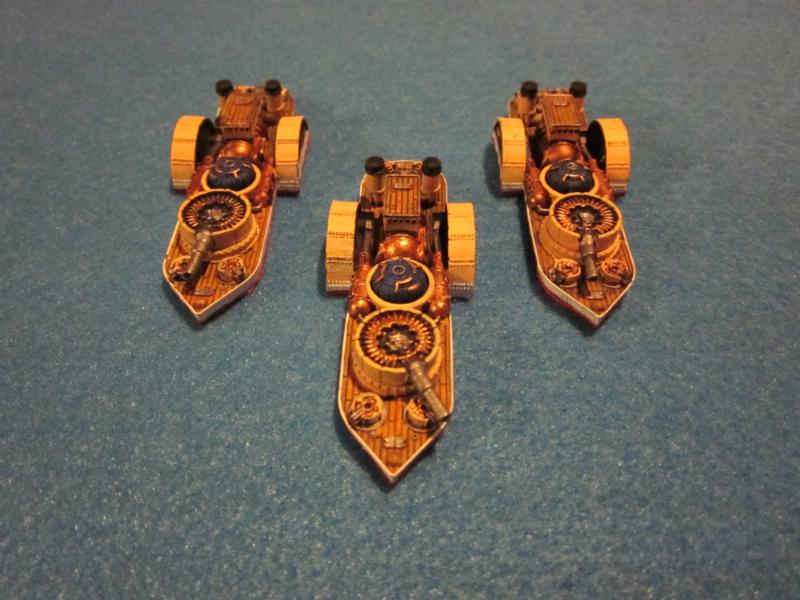Time for the second installment in my detailed review of the second edition of Dystopian Wars! This post will be fairly short, as Section B only has 5 pages in it (the shortest section by far!). Just like Section A, Section B is broken down into several sub-sections, incluiding Order of Play, Attacks & Damage, and Disorder.
Order of Play
This section details the turn order for DW 2.o. While generally similar to the turn order of the first edition, there have been a few more sub-phases added in, and a bit more detail added to how each step of each phase is executed. Each Game Turn is now divided into 3 phases: The Pre-Turn Phase, the Activiation Phase, and the End Phase, with several segments in each phase. No major changes there. The biggest addition to the Pre-Turn Phase is that it now contains a segment for bringing on Flanking and Reserve forces. This segement is sandwiched between the TAC segment (replacing the STAR Card segment) and the Initiative Segment (still the same 2D6 dice-off it has always been).
The Activation Phase will likewise be very familiar to DW veterans; this is where palyers alternate activating a squadron and performing its available actions. There are 18 seperate steps listed for this phase, split between the Command, Movement, Firing, Boarding, and Disorder phases. That seems like an awful lot of steps, but it really isn’t too bad; not every step will be necessary every time a squadron activates, and these steps are simply detailing what was already done for each activating squadron under the old rules. It’s just spelled out in more detail now. The third phase of each turn is the End Phase. This is also just as it was in the previous edition, though there is now a more detaild list of steps to execute, just like in the Activation Phase.
Attacks & Damage
This section explains the basic mechanics for damaging a model. They are largely unchanged; you are still going to be rolling D6s to get hits equal to or greater than the target’s Damage Rating, or DR. If you get enough hits, you can reach the target’s Critical Rating, or CR, and deal double damage plus a suitably nasty effect like a navigation lock or a fire. The only major change is that DW 2.o now makes a distinction between Indiscriminate Attacks and Targeted Attacks. In a nutshell, Indiscriminate Attacks are things like explosions or collisions. These attacks ignore positive and negative modifiers on the To-Hit value of dice, any armor-related Model Assigned Rules, and Defensive Generators. That’s right, you can no longer claim shield saves against things like mines or ram attacks! Targets attacks, on the other hand, are pretty much anthing that shoots (unless the weapon is identified as Indiscriminate in its profile), like guns, rockets, torpedoes, etc.
Disorder
Disorder is DW 2.o’s replacement for the “Morale” mechanics of the first edition. In general, Disorder Checks work pretty much the same as Morale Checks used to. You still need to perform a check when you lose a model from a squadron, your Commodore is killed, and if you end your activation with the squadron out of coherency. The test itself is still a 3D6 role, with a single success normally being required to maintain order. If the check is unsuccessful, the squadron then becomes Disordered. The effects of being Disordered are similar to the effects of being Broken; the squadron can’t link fire, use a TAC card, initiate boarding, etc.
However, instead of needing to take another test in the End Phase of the turn, squadrons automatically recover their order, which is great as it means that a squadron will neer be locked into disorderd status. The downside is that the squadron loses D3 hull and/or assault points in the process (the player gets to pick the split)! This will tend to make the consequences of Disorder a bit more severe than what they used to be; from my experience in 1.0 and 1.1, the most likely squadrons to be hit with a Broken status were small ship squadrons. Losing D3 HP/AP out of a squadron of frigates or corvettes is pretty significant, as those ship types don’t exactly have an abundance of either HP or AP.
There you have it! That’s all there is to Section B. As you can see, it is largely unchanged from the first edition of the game; most of what we see here is not so much a change as a more in-depth explanation of how each phase of the game is intended to go. Next time, I’ll be digging into Section C. This section is quite a bit chunkier, as it contains the detailed rules for movement, LOS, and shooting. There are some interesting departures from the previous edition to talk about in these areas! Until next time…

